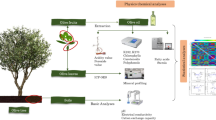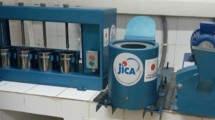Abstract
The nutritional properties and safety of olive oil are strongly dependent on the content of mineral nutrients and trace elements. Hence, this work assesses the content for quality and toxic metals of olive oils from three major Portuguese cultivars (‘Galega’, ‘Cobrançosa’ and ‘Picual’) obtained from olives in different ripening stages. This evaluation was achieved by flame atomic spectrometry and atomic absorption in a graphite furnace, depending on the metal to be analysed. The results showed mean concentrations of the mineral nutrients Ca and Mg of 20.00 µg g−1, and K and Na of 40.00 and 170.00 µg g−1, respectively, while the trace elements Fe, Co, Cu, Mn, Zn and Ni had mean values of 0.53, ≤ 0.01, 0.33, 0.10, 1.09 and 0.64 µg g−1, respectively. The mean content of the toxic metals Al, Cd, Pb and As were 27.46, 0.03, 0.09 and 0.36 µg g−1, respectively, which were according to the values proposed by European regulations. The evaluation of the data obtained by partial least square regression allowed the identification of the minerals with the strongest potential to discriminate between the season (Na, Cu, Zn and Ni) and the cultivar employed in the olive oil performance (Fe and Mn).



Similar content being viewed by others
References
Covas MI, Konstantinidou V, Fitó M (2009) Olive oil and cardiovascular health. J Cardiovasc Pharmacol 54(6):477–482
Huang CL, Sumpio BE (2008) Olive oil, the mediterranean diet, and cardiovascular health. J Am Coll Surg 207:407–416
Kountouri AM, Mylona A, Kaliora AC, Andrikopoulos NK (2007) Bioavailability of the phenolic compounds of the fruits (drupes) of Olea europaea (olives): impact on plasma antioxidant status in humans. Phytomedicine 14:659–667
Owen RW, Giacosa A, Hull WE, Haubner R, Wurtele G, Spiegelhalder B, Bartsch H (2000) Olive-oil consumption and health: the possible role of antioxidants. Lancet Oncol 1:107–112
Cabrera-Vique C, Bouzas PR, Oliveras-López MJ (2012) Determination of trace elements in extra virgin olive oils, a pilot study on the geographical characterisation. Food Chem 134:434–439
González A, Armenta S, de la Guardia M (2010) Adulteration detection of argan oil by inductively coupled plasma optical emission spectrometry. Food Chem 121:878–886
Zeiner M, Juranovic-Cindric I, Skevin D (2010) Characterization of extra virgin olive oils derived from the Croatian cultivar Oblica. Eur J Lipid Sci Technol 112:1248–1252
Demirözü B, Sökmen M, Uçak A, Yılmaz H, Gülderen S (2002) Variation of copper, iron and zinc levels in pekmez products. Bull Environ Contam Toxicol 69:330–334
Kabata-Pendias A (2010) Trace elements in soils and plants, 3rd edn. Taylor & Francis, Boca Raton
Anthemidis AN, Arvanitidis V, Stratis JA (2005) On-line emulsion formation and multi-element analysis of edible oils by inductively coupled plasma atomic emission spectrometry. Anal Chim Acta 537:271–278
Castillo JR, Jiménez MS, Ebdon L (1999) Semiquantitative simultaneous determination of metals in olive oil using direct emulsion nebulization. J Anal Atom Spectrom 14:1515–1518
Uceda M, Hermoso M (1998) La calidad del aceite de oliva. In: Barranco D, Fernàndez-Escobar R, Rallo L (eds) El Cultivo del Olivo. Junta de Andalucia Ediciones Mundi-Prensa, Madrid, pp 547–572
Gouvinhas I, Machado N, Cunha M, Pereira M, Matos C, Gomes S, Lopes J, Martins-Lopes P, Barros I (2015) Trace element content of monovarietal and commercial Portuguese olive oils. J Oleo Sci 64(10):1083–1093
Mendil D, Uluözlü ÖD, Tüzen M, Soylak M (2009) Investigation of the levels of some element in edible oil samples produced in Turkey by atomic absorption spectrometry. J Hazard Mater 165:724–728
Martínez-Ballesta MC, Domínguez-Perles R, Moreno DA, Muries B, Alcaraz-López C, Bastías E, García-Viguera C, Carvajal M (2010) Minerals in plant food: effect of agricultural practices and role in human health. A review. Agron Sustain Dev 30:295–309
Ieggli CVS, Bohrer D, Do Nascimento PC, De Carvalho LM (2011) Flame and graphite furnace atomic absorption spectrometry for trace element determination in vegetable oils, margarine and butter after sample emulsification. Food Addit Contam 28:640–648
Karabagias I, Michos C, Badeka A, Kontakos S, Stratis I, Kontominas MG (2013) Classification of Western Greek virgin olive oils according to geographical origin based on chromatographic, spectroscopic, conventional and chemometric analyses. Food Res Int 54:1950–1958
Benincasa C, Lewis J, Perri E, Sindona G, Tagarelli A (2007) Determination of trace element in Italian virgin olive oils and their characterization according to geographical origin by statistical analysis. Anal Chim Acta 585:366–370
Zeiner M, Steffan I, Cindric IJ (2005) Determination of trace elements in olive oil by ICP-AES and ETA-AAS: a pilot study on the geographical characterization. Microchem J 81:171–176
Benincasa C, Gharsallaoui M, Perri E, Briccoli Bati C, Ayadi M, Khlif M, Gabsi S (2012) Quality and trace element profile of tunisian olive oils obtained from plants irrigated with treated wastewater. Sci World J. doi:10.1100/2012/535781
Camin F, Larcher R, Perini M, Bontempo L, Bertoldi D, Gagliano G, Nicolini G, Versini G (2010) Characterisation of authentic Italian extra-virgin olive oils by stable isotope ratios of C, O and H and mineral composition. Food Chem 118:901–909
Huskisson E, Maggini S, Ruf M (2007) The role of vitamins and minerals in energy metabolism and well-being. J Int Med Res 35:277–289
Pinto P, Saraiva ML, Lima JL (2006) A flow sampling strategy for the analysis of oil samples without pre-treatment in a sequential injection analysis system. Anal Chim Acta 555:377–383
Choe E, Min DB (2006) Mechanisms and factors for edible oil oxidation. Compr Rev Food Sci F 5:169–186
Shenkin A (2008) Basics in clinical nutrition: physiological functions and deficiency states of trace elements. e-SPEN 3:255–258
Bakkali K, Martos NR, Souhail B, Ballesteros E (2012) Determination of heavy metal content in vegetables and oils from spain and morocco by inductively coupled plasma mass spectrometry. Anal Lett 45:907–919
Zhu F, Fan W, Wang X, Qu L, Yao S (2011) Health risk assessment of eight heavy metals in nine varieties of edible vegetable oils consumed in China. Food Chem Toxicol 49:3081–3085
Flora SJS, Pachauri V (2010) Chelation in metal intoxication. Int J Environ Res Publ Health 7:2745–2788
Acar O (2012) Evaluation of cadmium, lead, copper, iron and zinc in Turkish dietary vegetable oil and olives using electrothermal and flame atomic absorption spectrometry. Grasas Aceites 63(4):383–393
Bakkali PK, Ballesteros E, Souhail B, Martos NR (2009) Determination of metal traces in vegetable oils from Spain and Morocco by graphite chamber atomic absorption spectroscopy following microwave digestion. Grasas Aceites 60:490–497
World Health Organization/Food and Agriculture Organization (WHO/FAO) (2004) Vitamin and 2792 mineral requirements in human nutrition. Report of a joint FAO/WHO expert consultation, 2793 Bangkok, Thailand, 21–30 September 1998. Geneva, 341
EFSA (2009) Scientific opinion on arsenic in food. EFSA J 7(10):1351
EFSA (2010) Scientific opinion on lead in food. EFSA J 8(4):1570
Acknowledgments
This work was supported by the Project PhD grant SFRH/BD/78013/2011 from the Fundação para a Ciência e Tecnologia to IG. This work was also supported by the Project INNOFOOD–INNOvation in the FOOD sector through the valorization of food and agro-food by-products—NORTE-07-0124-FEDER-0000029, financed by the North Portugal Regional Operational Programme (ON.2–O Novo Norte) under the National Strategic Reference Framework (QREN), through FEDER, as well as by PIDDAC through FCT/MEC and by the project PEst-OE/AGR/UI4033. RDP was supported by a Postdoctoral contract from the Portuguese Foundation for Science and Technology within the framework of the National Scientific and Technologic System. N.F.L. Machado kindly acknowledges a post-doctoral research grant from the Centre for the Research and Technology of Agro-Environmental and Biological Sciences, with the reference BI/CITAB/UTAD/QUI/2015.
Author information
Authors and Affiliations
Corresponding author
About this article
Cite this article
Gouvinhas, I., Domínguez-Perles, R., Machado, N. et al. Effect of Agro-Environmental Factors on the Mineral Content of Olive Oils: Categorization of the Three Major Portuguese Cultivars. J Am Oil Chem Soc 93, 813–822 (2016). https://doi.org/10.1007/s11746-016-2827-4
Received:
Revised:
Accepted:
Published:
Issue Date:
DOI: https://doi.org/10.1007/s11746-016-2827-4




